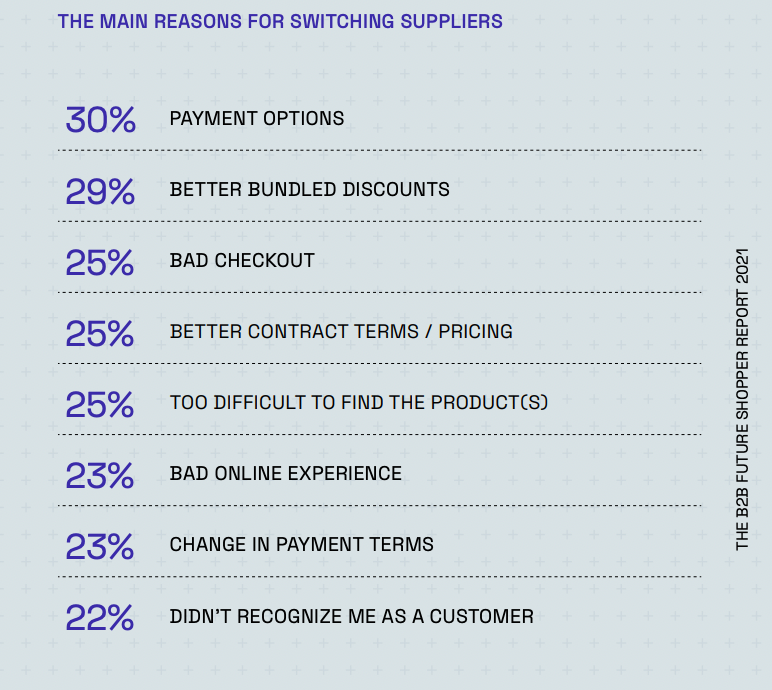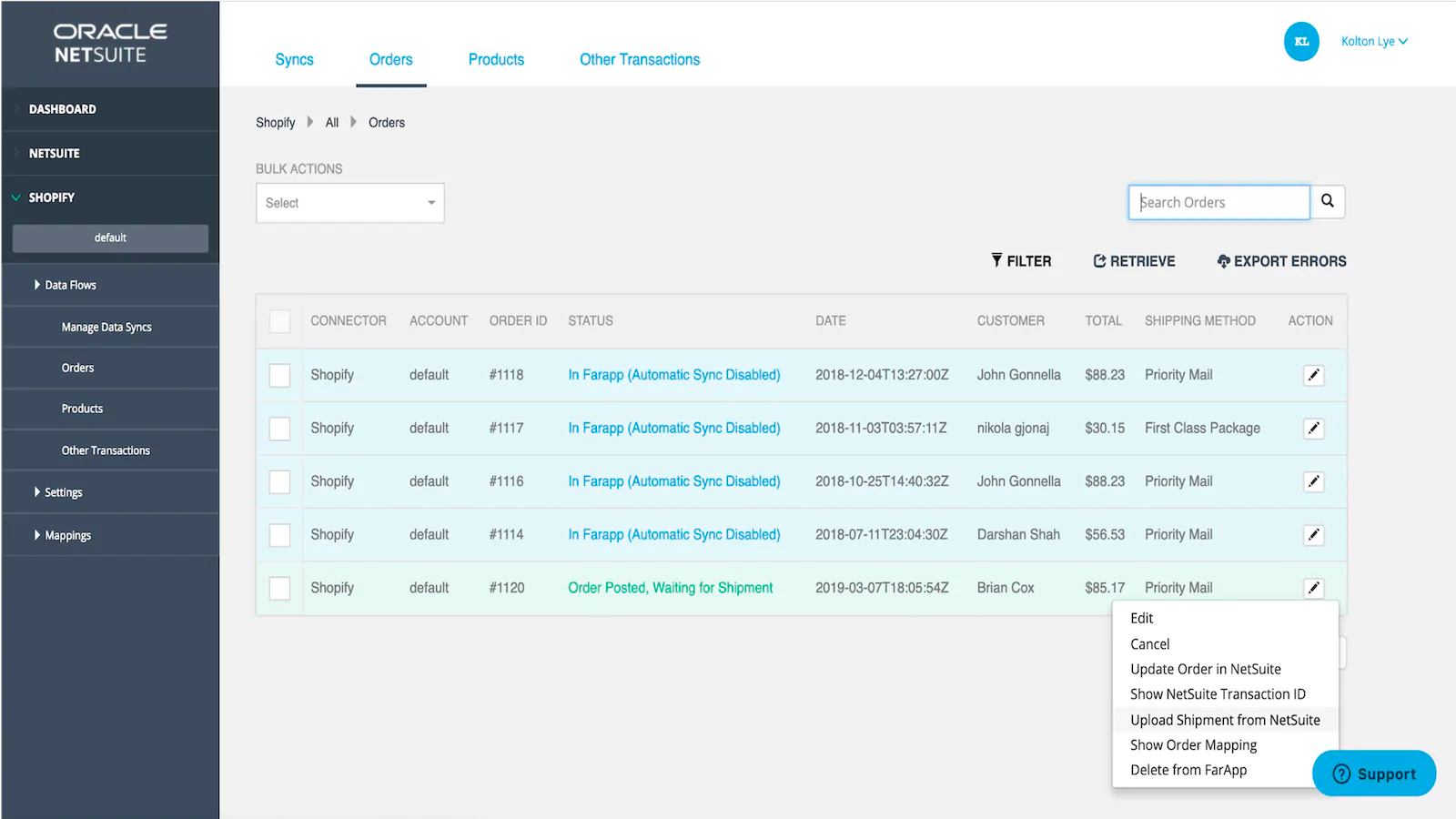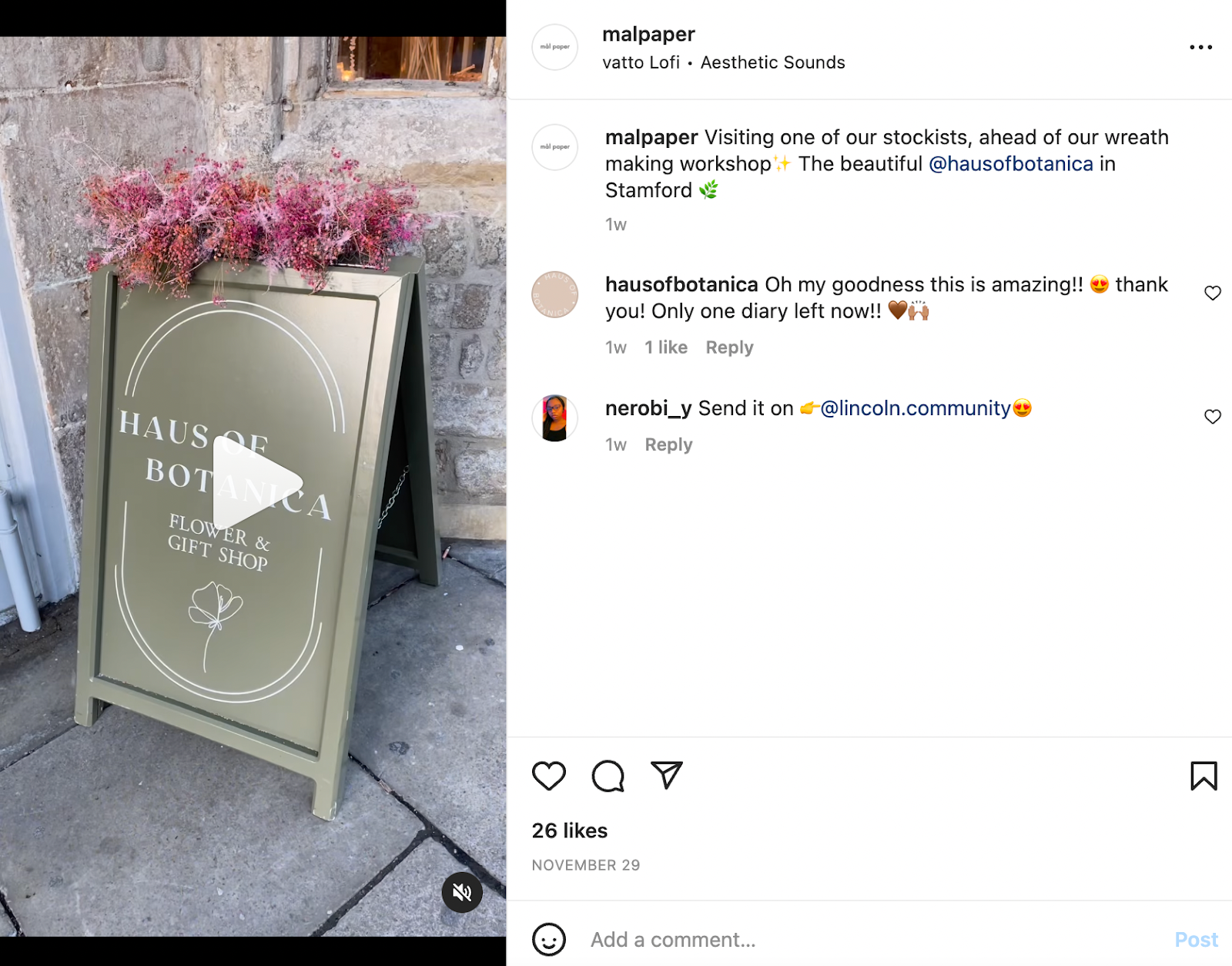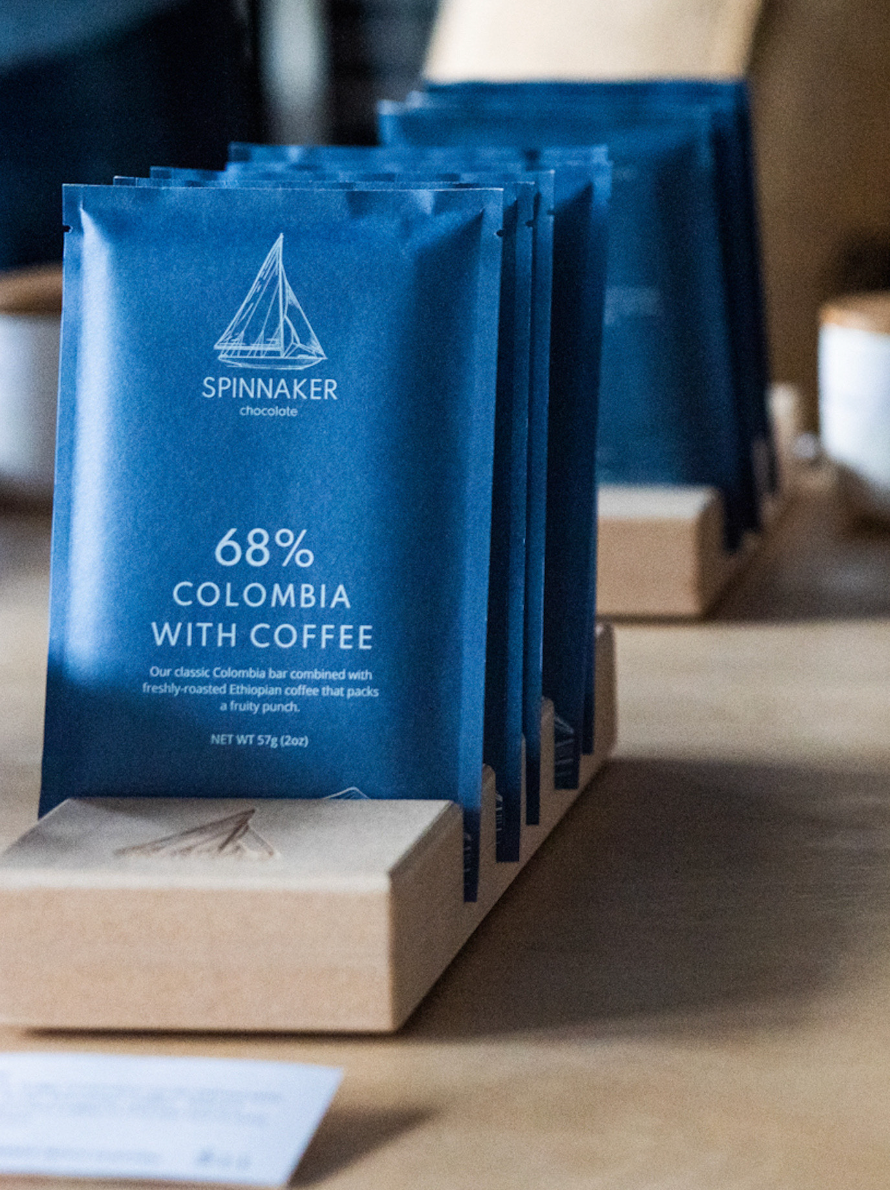Long-lasting relationships are the key to scaling a business-to-business (B2B) company. If buyers are happy with their purchase and have a positive experience with your brand, they’re more likely to return for months (if not years) to come.
Not only does that alleviate pressure on your B2B marketing team to consistently generate new leads, but it also makes a seismic difference to your bottom line. Study after study has proven that repeat customers are the secret to profitability—an elusive goal to chase in B2B, when products are already being sold at up to half their retail price.
What is B2B customer service?
B2B customer service ensures companies that buy from your business are satisfied with their purchase. World-class B2B support provides buyers with the information they need, in real time—often without having to contact a support team.
The importance of strong B2B customer experiences
It’s important for each interaction a B2B customer has with your brand to be positive. Studies show that 38% of global B2B buyers identified customer satisfaction as one of their top KPIs—and for good reason.
If each touchpoint a B2B customer has with your brand is to be positive, it impacts future business. Happy customers are much more likely to praise your business publicly. Glowing reviews, social media posts, or word-of-mouth referrals build credibility and brand equity. A buyers’ tight-knit network will come to recognize your business as the go-to supplier for a specific type of product.
The more reliable and professional you can be, the more likely someone is to continue being a customer. And as we all know, repeat customers are the key to a healthy business.”
—Kelly Van Arsdale, co-founder and CEO of Spinnaker Chocolate
Similarly, almost a quarter of B2B buyers have switched suppliers due to a bad online experience. Nail the customer experience and benefit from long-term relationships with your customers. It’s these repeat customers that form almost half of a business’s total orders.
How to provide a world-class B2B customer service
-
Vet potential buyers before purchasing
-
Allow customers to self-serve
-
Be proactive, rather than reactive
-
Offer omnichannel support
-
Keep buyers updated on shipments
-
Promote your resellers’ businesses
-
Provide marketing materials
-
Professionally manage B2B reverse logistics
-
Regularly collect feedback to improve support
1. Vet potential buyers before purchasing
Expanding a B2B operation is no small feat. The purchasing process for each individual buyer is complex, often involving up to 10 stakeholders and spanning several months. Reserve your sales reps’ time, and still give the one-to-one interactions your existing buyers want, by vetting buyers before they purchase.
Involve vetting as part of your sales representatives’ responsibilities. Build a customer persona document to benchmark new prospects on. Detail the type of company most likely to successfully resell your inventory, including their social media following, annual revenue, and industry they operate within.
Similarly, detail the type of person making the inquiry. Are merchandising managers more likely to convert (and to do so faster) than CEOs? Prioritize leads share the most traits as your buyer persona.
Both parties need to do research on one another to make sure that it’s a great fit. If communication needs to happen, keep the lines open so there is no confusion and it turns into a win-win for everyone.”
—Jamie Batiste, founder of Rejected Hearts Club
The added benefit of vetting B2B brands pre-purchase is that your brand remains consistent. Resellers will be attaching your brand to theirs.
“One thing that we’ve been conscious of is being very strategic with who we look to work with,” says Will Stewart, owner of Cedar Spring Recreation. “The retailers we work with are going to be a reflection of our brand. We’re building a company and brand we’re proud of, and we expect the same from our B2B customers."
2. Allow customers to self-serve
Long, complex sales funnels don’t need to slow down the decision-making process. Move your B2B business online and allow pre-qualified buyers to self-serve.
Research shows that 60% of B2B buyers switched suppliers in the past year due to a bad checkout experience. Almost half cite a bad online experience in general, contributing to 89% of companies that find buying online more complicated than offline.

Plus, almost half of B2B buyers would prefer not to interact with a sales rep throughout their buyer journey. Gartner credits self-serve digital experiences as the secret to providing exceptional customer support.
There’s no beating around the bush: buyers want purchasing to be easier. With Shopify’s B2B ecommerce platform, you can deliver those excellent self-service experiences, alleviating strain on your sales reps and support team. You can:
-
Open a password-protected portal for B2B buyers
-
Assign wholesale price lists to business customers
-
Remind buyers of when their invoices are due
-
Provide personalized product recommendations at scale
“The nice part about using Shopify to run our wholesale store is we don’t have to use the antiquated systems of purchase orders and PDFs of our product catalog. We process all of our orders through our Shopify wholesale store with net terms and send invoices separately.”
—Kelly Van Arsdale, co-founder and CEO of Spinnaker Chocolate

Shaunak Amin, co-founder and CEO of SwagMagic, says, “Branded client portals enable our customers to view their active orders, track shipments, and track the live inventory we store for them in our warehouse. These features provide greater transparency in stock quantities and reordering needs.
“These portals enable our clients to consult in real time with our support team members anytime they have a question or issue we need to address immediately,” Shaunak says. “Because when you’re operating in the global marketplace, you’ll have clients in various time zones interacting with your business, navigating their crunch times and emergencies.
“And providing them with instant access to all the resources they need is what helps them extract the most value out of your business during their most crucial moments.”
Reduce friction as much as possible! Store owners are just as busy as the rest of us. The easier it is for them to bring on your product, the more likely they are to do it.”
—Kelly Van Arsdale, co-founder and CEO of Spinnaker Chocolate
3. Be proactive, rather than reactive
Brands that proactively communicate with ecommerce customers stay front of mind, helping them resolve a problem before a buyer has reached out and delivering a better B2B customer experience.
Anticipate what a customer needs and provide it without forcing them to initiate the conversation. Gartner found buyers who receive helpful information throughout their buying decision were 2.8 times more likely to experience purchase ease, and three times less likely to regret their decision.
This is where the B2B sales funnel comes into play: By identifying the pain points, frustrations, and goals a customer has throughout their B2B ecommerce experience, you can automate the delivery of helpful content that guides them toward a purchase. (If you don’t, there’s a good chance you’ll lose them to a competitor that does.)
Here’s what proactive B2B customer support might look like pre-purchase:
-
Top of the funnel: Blog posts around customer pain points, optimized to rank in search engines for the keywords they’re searching for.
-
Middle of the funnel: A retargeted LinkedIn advert promoting webinars with an industry expert to build credibility, trust, and showcase knowledge.
-
Bottom of the funnel: An email marketing campaign that showcases case studies to demonstrate how a similar B2B company saw a return on their investment after purchasing your product.
Once a B2B organization has made its purchasing decision, don’t sit back and wait for them to present themselves with a problem. Continue providing a personalized experience with post-purchase email campaigns. Share optimal storage solutions, retail display ideas, or emerging social media trends that help them market their products.
Automate this personalized B2B customer service with Shopify Flow. Define triggers typical with each stage of the funnel, and build workflows to proactively provide helpful information. It allows you to scale B2B customer support and reduce pressure on your team.
Shopify Flow opens us up to strategic initiatives that grow the business. We can better use our team and their skill sets.”
—Mehmet Dokumcu, head of ecommerce at Good American
4. Offer omnichannel support
Much like DTC customers, B2B organizations often have questions about their purchase. The topic of these support conversations differ. But the method customers expect to engage with retailers is consistent across the board, especially considering 90% of B2B buyers want DTC-style customer experiences from the suppliers they buy from.
Provide that user experience to B2B customers with omnichannel support. That includes customer service contact through digital channels like:
-
Email. Create a shared inbox for your support team to receive and distribute support inquiries. If you process a large volume of orders each month, separate B2B emails from DTC support.
-
Marketplace inboxes. Popular B2B marketplaces have built-in messaging functionality that allows buyers and sellers to communicate within the platform.
-
Social media. Allow B2B customers to send a direct message on the social media platforms they’re using. The most common platforms used by B2B buyers are LinkedIn, Twitter, and Facebook.
-
Live chat. Almost half of customers expect a response to their support query within four hours. Some 12% expect answers in 15 minutes or less. Meet those customer expectations with a live chat feature on your B2B ecommerce website.
-
Chatbots. Chatbots with artificial intelligence (AI) capabilities provide B2B customers with real-time answers to their questions. Alleviate pressure on your support team and increase customer satisfaction simultaneously.
“[Shopify’s] chat feature has allowed our customers to get fast, immediate support from us. I love that the app gives us push notifications so we can respond on the go in real time. The best part is that it pulls Shopify customer data so we can see if they’ve purchased from us before or are a first-timer, so we can respond with more background context.”
—Michelle Razavi, founder and CEO of ELAVI
Alternatively, experiment with new technology that allows B2B buyers to communicate via WhatsApp-style voice notes. Jessica-Rose, head of CX, says 310 Nutrition uses Hark to deliver great customer support: “Hark is a CX channel that provides an easy way for our customers to contact us by sending videos or audio clips of their problems/questions/issues.
“Our customers love submitting their issues like this since it limits back and forth and honestly is fun. In the like, our agents love working on Hark tickets because they are easiest to solve, since all the information is right there in front of them and they also tell me all day how fun they are.”
Employ a customer relationship management (CRM) platform like RichPanel, HubSpot, or Endear to monitor these support messages. Each time a new B2B customer support inquiry comes through, it will show:
-
The decision-makers involved in the B2B buying decision
-
Which channel(s) they’ve used to contact support previously
-
The sales representative they’ve spoken to
-
The subject of their previous enquiry, and the outcome
-
Any touchpoints they’ve had with your brand since their previous support request
-
Information collected through the post-support chat feedback form
Having this information at hand allows you to provide omnichannel experiences to your customers. There’s no need for buyers to remember the channel they last used to contact a brand, nor re-explain the issue they’re struggling with. Your customer support team will be ready to solve the issue and improve satisfaction.
5. Keep buyers updated on shipments
The buying experience doesn’t conclude once a B2B order leaves your warehouse. Once the ordering process comes to an end, keep lines of communication open with delivery transparency.
Clare Holden, founder of White Night, says, “Once you have the order and sales terms agreed, it is essential to maintain contact and keep them updated with the delivery dates.
“You always need to do quality control before the order is shipped. Once the order has arrived, reach out to check in with them. Even when you have been paid, it is always a good idea to keep in touch to see how the product is selling.”
The retailers you’re selling to also distribute products to customers. They’re clued up on how long it takes for a product to be fulfilled and shipped. Retailers that use UPS, for example, had an average transit time of 2.96 days pre-pandemic. That’s since dropped to 2.35 days, faster than before the pandemic, driving the trend of speedy B2B delivery.
Need help committing to speedy delivery timeframes? Third-party logistics (3PL) partners take the pressure off your plate. Services like Shopify Fulfillment Network, Shipbob, and Veeqo integrate with Shopify’s B2B ecommerce platform to automatically update buyers on the status of their shipment—no manual data entry required.
The vast majority of 3PLs also have advanced fulfillment technology. Shopify’s Chuck robot, for example, speeds up the fulfillment process and gets orders out the door faster, so you can increase fulfillment speed and order accuracy simultaneously.
Better order management tools that sit between the ordering platform and the warehouse will become commonplace to provide order fulfillment routing to the best location with available inventory, allowing businesses to deliver wholesale orders as efficiently as their B2C orders.”
—Andreas Blomst, GM of Extensiv
Integrate enterprise resource planning (ERP) software for greater visibility over B2B shipments. Shopify’s integration with NetSuite automatically pulls data from the following platforms and displays it in one dashboard:
-
Customer relationship management platform
-
Supply chain management software
-
Warehouse management systems (either yours or a 3PL’s)

6. Promote your resellers’ businesses
One of the biggest differences between B2B and business-to-consumer (B2C) ecommerce is the pain points each customer is trying to solve. End consumers have pain points specifically related to the product. Business customers, on the other hand, are usually solving a business problem.
Take wholesalers, for example. This type of business sources products at a low price, in bulk, and resells them for a profit. Pain points a wholesaler is trying to solve when evaluating new purchases might include:
-
Increasing foot traffic to their store
-
Improving product sell-through rate
-
Remaining competitive
If your business sells both B2B and DTC, you’re in a fortunate position. You likely have a large enough audience to promote your wholesalers’ businesses—alleviating their pain point before and after making a purchase.
White Night’s Clare Holden says, “Once you are selling through their business, whether it be a brick-and-mortar store or their ecommerce site, you may want to let your customers know that your product is available there.
“Promote it on your socials and update your website to include them as one of your stockists,” Clare says. “If it is a different geographical area to where your main customers are, try and find micro-influencers based in that zone to post about getting your product there. It will help sales for them and also open your business up to a new demographic of customers.”
Mal Paper is one example of how B2B brands can promote their customers’ businesses. If wholesale customers tag the brand in their social media posts, Mal Paper reshares it to its own profile, positioning the store in front of its more than 14,000 Instagram followers.

7. Provide marketing materials
It’ll be more difficult to promote your resellers’ businesses if you’re B2B only. It’s unlikely you’ll have consumers’ attention to divert toward a wholesalers’ store. That doesn’t mean your involvement in marketing is off the table.
Provide B2B marketing materials to help customers sell your products. That includes:
-
Retail displays
-
Product packaging and inserts
-
High-quality photography and videos
-
Product information, such as price sheets and average sell-through rate to benchmark against
Not only do these marketing materials solve a B2B customers’ pain point of generating a return on their purchase, but you maintain control over your brand. Items are displayed and marketed in a way that’s consistent with your own marketing strategy, helping to build brand recognition and equity on channels typically outside of your control.
Spinnaker Chocolate is one B2B retailer that offers free retail displays for its customers. Co-founder and CEO Kelly Van Arsdale says, “All retail store owners struggle with displaying new products, so if you can shoulder that burden for them, that’s a huge customer experience win.
“This is a win for us, for the retailer, and most importantly, for the end consumer. We’re hoping that our customer experience will be the same wherever consumers go so that our products are immediately recognizable. In other words, our retail display is part of our brand identity.”

Caption: An example of the retail displays Spinnaker Chocolates gives to its B2B customers.
8. Professionally manage B2B reverse logistics
There are various reasons B2B customers initiate a return, from items becoming damaged mid-shipment to slow delivery speeds. Take proactive measures to minimize returns, such as wrapping B2B orders in protective materials to prevent in-transit damages or enlisting the help of a 3PL that uses warehouse technology to improve accuracy.
Unfortunately, while you can do your best to minimize B2B returns, some are unpreventable. Buyers could have ordered the incorrect quantity or product. Others no longer need the items they’ve purchased due to a change in circumstances.
Regardless of who is to blame, give buyers the same excellent service throughout the B2B returns process. The way you manage this process has a domino impact on customer loyalty and retention—studies show that if customers have a positive returns experience, 92% will return to buy again.
That means:
-
Displaying a clear B2B returns policy. Almost a third of B2B buyers said it’s important that the suppliers they purchase from have an easy return policy. Include what types of product qualify for a return, the returns window, and the credit you’ll give (such as a refund or exchange).
-
Returns tracking. Allow buyers to initiate a return through their company profile on your B2B storefront. Here, they can view all previous orders, generate a returns label, and track the status of their return without having to contact your support team.
-
Fast return processing. Once an item arrives back at your warehouse, confirm whether it’s eligible for a return and inform the customer. Process their refund—be that a credit note, cash refund, or exchange—as quickly as possible. Consider employing a 3PL that offers reverse logistics services to speed up the process.
9. Regularly collect feedback to improve support
How do you know if your commitment to B2B customer service is translating well enough to result in repeat business? Dig deep into customer support metrics to benchmark data. Use this as a starting point to measure the effectiveness of your strategy.
Choose a B2B ecommerce platform that silos wholesale analytics into a sleek, easy to navigate dashboard. Shopify, for example, allows you to filter data from B2B orders to easily track sales, orders, profits, customers, and finances from the same backend that powers your B2C store.
Enlist the help of a customer feedback tool to gain supporting qualitative and quantitative data. Shopify apps like Reveal and Zigpoll email customers once a support inquiry is resolved. You’ll uncover important metrics that improve your strategy going forward.
B2B customer service metrics to pay attention to include:
-
Net promoter score (NPS)
-
Customer satisfaction
-
Whether their issue was resolved
-
What elements of support could be improved
-
Whether they’d purchase again
If B2B customers are unhappy with their experience because the returns policy was unclear, for example, rectify the issue by clearly linking to your returns policy at B2B checkout. It’s a small tweak that improves the experience for future customers, while reducing the volume of support tickets that come your way.
Deliver excellent customer experiences with your B2B storefront
If you take one thing away from this guide, let it be this: B2B buyers are no different than B2C customers. Both want personalized shopping experiences from the brands they buy from, and support options that slot within the channels they’re already using.
There’s no need to build complex or expensive ecommerce solutions to sell B2B online. With Shopify, you’ll cater to both B2B and B2C buyers with personalized storefronts and marketing campaigns—all from a single back end.
Expanding a B2B business is no small feat. Get the tools, advice, and support you need to scale your business with Shopify's B2B ecommerce platform.
Read more
- B2B Ecommerce: Everything You Need to Know to Get Started
- B2B Ecommerce: Why Taking Your B2B Business Online is a Smart Strategy to Scale
- 12 B2B Ecommerce Trends To Shape Your Business in 2023
- What Is Wholesale B2B and How To Sell To Customers in 2023
- What Are B2B Payments? Methods & Processing Systems
- B2B Marketplaces: What They Are, How to Succeed, and 8 Marketplaces to Consider
- Find the perfect domain name
B2B customer service FAQ
What is B2B customer success?
B2B customer success means helping your buyers reach their goals. It’s a responsibility that typically falls within customer service or support teams. Representatives guide buyers through issues and solve problems—most often, using your product.
How does B2B measure customer experience?
The best way to track B2B customer experience is to collect feedback from buyers. Metrics like customer satisfaction score (CST), net promoter score (NPS), and customer retention rate can also measure how happy customers are.
How important is customer experience in B2B?
Customer experience is extremely important for B2B companies. Buyers who have positive experiences with your online store are more likely to buy again and refer you to their network. This contributes to a stronger reputation.
How would you deal with a difficult customer in B2B?
-
Apologize—even if it’s not your fault
-
Use active listening and empathize with the buyer
-
Establish the reason for the complaint
-
Communicate with teams to uncover why service failed
-
Relay the cause to your buyer
-
Provide a solution
-
Offer an incentive to make them stay, such as a next order discount




